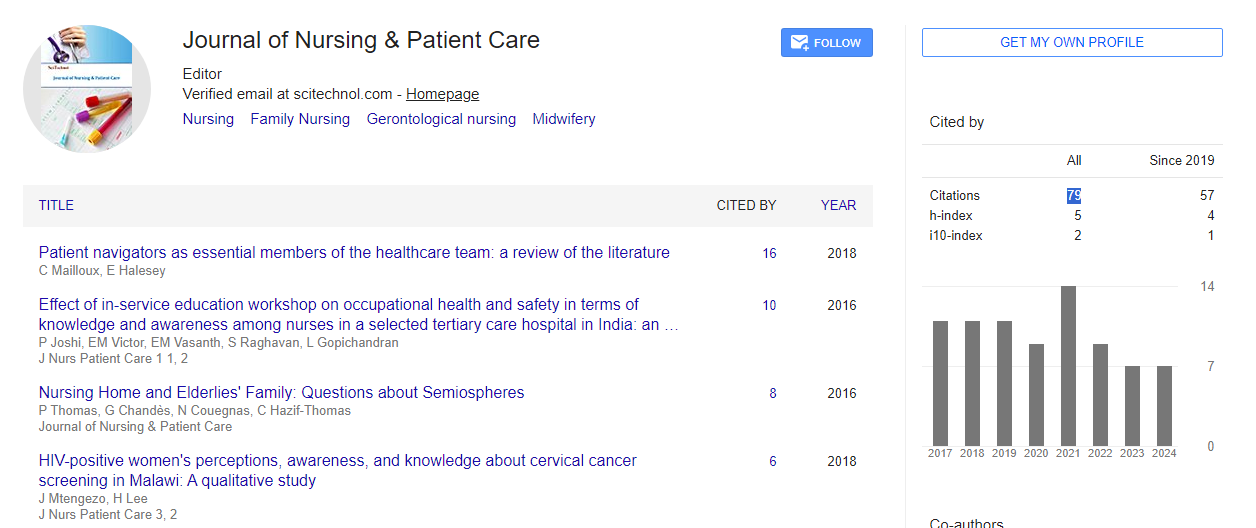Commentary, J Nurs Patient Care Vol: 8 Issue: 1
Integrating Technology into Midwifery Practice: Opportunities and Challenges
Murat Kunelbayev*
1Department of Nursing, Department of Nursing, King AbdulAziz University, Tole Bi Street 94, Almaty 050000, Kazakhstan
*Corresponding Author:Murat Kunelbayev
Department of Nursing, King AbdulAziz
University, Tole Bi Street 94, Almaty 050000, Kazakhstan
E-mail: muratnurbapa@mail.ru
Received date: 16 February, 2023, Manuscript No. JNPC-23-93401;
Editor assigned date: 20 February, 2023, PreQC No. JNPC-23-93401 (PQ);
Reviewed date: 10 March, 2023, QC No JNPC-23-93401;
Revised date: 17 April, 2022, Manuscript No. JNPC-23-93401 (R);
Published date: 24 April, 2023, DOI: 10.4172/2573-4571.1000025
Citation: Kunelbayev M (2023) Integrating Technology into Midwifery Practice: Opportunities and Challenges. J Nurs Patient Care 8:1.
Keywords: Nursing Practices
Description
The role of midwives in promoting positive maternal and neonatal outcomes, the importance of evidence-based practice, and the challenges faced by midwives in providing quality care.
Midwives play an important role in promoting positive maternal and neonatal outcomes. Midwives work to promote healthy pregnancies, monitor fetal development, and provide education and support to women throughout the childbirth process. They also play an important role in promoting breastfeeding and providing postpartum care to ensure the well-being of both mother and child.
Evidence-based practice is an essential aspect of midwifery, ensuring that healthcare professionals provide care based on the latest research and clinical evidence. Midwives must stay up-to-date with the latest research in obstetrics and gynecology, using this knowledge to inform clinical decision-making and promote positive patient outcomes. Evidence-based practice is also important in promoting safe and effective childbirth practices, reducing the risk of complications and improving maternal and neonatal outcomes.
Midwives face several challenges in providing quality care, including staff shortages, limited resources, and a lack of support from healthcare systems. Midwives must work to navigate these challenges effectively, providing compassionate care to women and their families while promoting positive patient outcomes. They must also work to address issues such as maternal mortality and health disparities, promoting equity in maternal and neonatal care.
Integrating technology into midwifery practice offers both opportunities and challenges. On the one hand, technology can enhance the quality of care provided to women and their families, improving maternal and neonatal outcomes. On the other hand, integrating technology into midwifery practice requires careful consideration of the potential risks and benefits, as well as the need for appropriate training and support for midwives.
One of the primary opportunities presented by technology in midwifery practice is the ability to provide remote monitoring and telehealth services, allowing midwives to monitor women's health and well-being from a distance. This can be particularly beneficial for women living in rural or remote areas, who may have limited access to healthcare services. Technology can also be used to enhance communication and collaboration between midwives and other healthcare professionals, improving the quality of care provided.
However, integrating technology into midwifery practice also presents several challenges. One of the primary challenges is the need for appropriate training and support for midwives, who may be unfamiliar with new technologies. Midwives must be trained to use new technologies effectively, ensuring that they can provide safe and effective care to women and their families. Additionally, the use of technology in midwifery practice raises concerns about privacy and security, highlighting the need for appropriate safeguards to protect patient data.
 Spanish
Spanish  Chinese
Chinese  Russian
Russian  German
German  French
French  Japanese
Japanese  Portuguese
Portuguese  Hindi
Hindi 